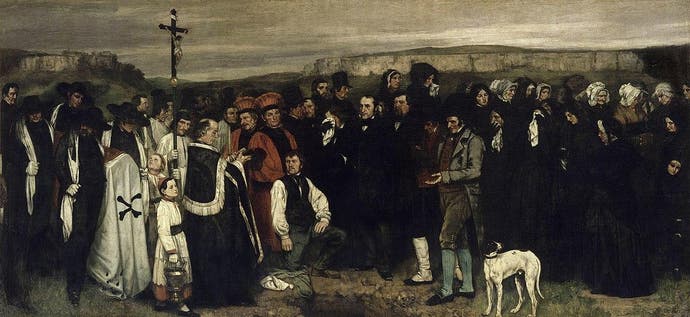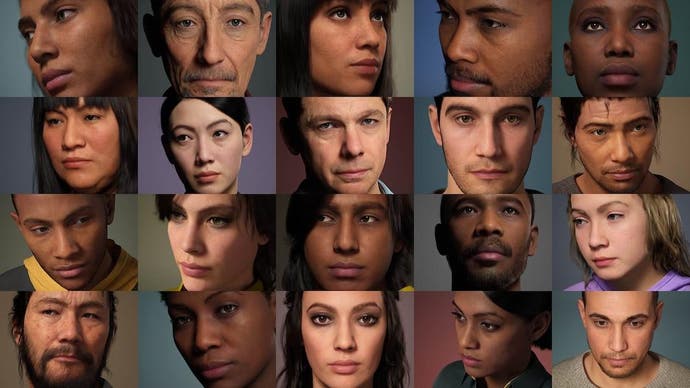From Cyberpunk 2077 to Animal Crossing, Realism is an underlying part of video games
Unpicking the history of an art movement.
What do Animal Crossing: New Leaf and Cyberpunk 2077 have in common? The answer is obvious, you might reply: they are both video games. That is correct, but there is another, less obvious, answer which is that they both represent Realism. Specifically, the artistic movement of Realism that began in France in the mid-1800s and has, in one form or another, continued to evolve to this day.
The painter who first coined this expression was Gustave Courbet. He presented paintings that shocked the artistic elite of the time. His painting, ‘A Burial at Ornans’ (1850-51), was a portrayal of the funeral of Courbet’s great uncle; a peasant funeral and on a scale deemed excessive for such lowly subjects. The 315 x 668cm canvas was all encompassing, immersing the viewer in the hidden reality of the peasantry, which the art-viewing aristocracy would have never normally have acknowledged. Placing such an importance to the lives of the impoverished and rural populations unsettled and threatened the upper classes in post-revolutionary France.

Realism is an art movement term that can easily applied to triple-A video game titles with their advanced graphics and commitment to mimicking human nature and experiences and, in particular, to their photorealistic, visual excellence. Nonetheless, Realism elements can also be found in video games that are not celebrated for any photorealistic qualities.
So, to return to a variation on the original question, what does a 19th century painting style have in common with an animated video game featuring a cartoon-type human who lives in a village populated by fantasy animals - or, indeed with a futuristic, cyberpunk video game?
The answer is that they both share the characteristics of Realism. In the case of Animal Crossing: New Leaf, this is the tethering of a virtual world to the real world. This game’s main attraction to a player is its offering of reassuring predictability; a carefully crafted, controlled experience. However, into this bastion of sureness, the developers have inserted the unpredictable element of Realism through the concept of ‘luck’. Animal Crossing: New Leaf, for all its cartoon-like characters and settings, jolts us into a sense of reality by injecting into the game real-life chance events.
One such injection is the fact that the play character, unbeknownst to the player, can be assigned ‘bad luck’, resulting in the character being constantly subjected to tripping or falling over and thus, irrationally, impairing their expected playability. The seemingly inconsequential act of tripping transports the player out of their comfort-zone and into a pocket of challenging reality, thrusting the player back into the actuality of the unpredictable real world.
This duality is found in many video games; the promise of player escapism coupled to an unexpected, hidden level of reality.
Sometimes, however, the element of Realism can be taken too far. Far Cry 2 has been mocked by players for its slavish commitment to Realism while patently obviously utilising non-realistic ideas in parts of the game. For instance, the game generates constant reminders of the playable character’s need for antimalarial drugs, while, on the other hand, also employing the clearly fanciful concept of fixing bullet holes in a jeep with a wrench! This game highlights the difficulties experienced by the game developers when trying to attain Realism but still achieving the fantastical nature of video games themselves.
Cyberpunk 2077 utilises an artistic aesthetic that aligns with Realism as well as mimicking human experience by using conversation options. Some of the game endings are dependent on incidental conversations whereas others are the result of conversational choices. Realism for many people, however, is purely visual as experienced in Photorealism. Photorealism relies on the assumption that photographs, used as inspiration, offer an authentic vision of reality or, in the case of the video game, an accurate impression of reality. Games like Cyberpunk 2077 mix the familiar with the unfamiliar to create an environment in which the player suspends their disbelief of the more fantastical elements due to the game’s underlyingly realistic nature.
Realism is synonymous with ‘truth’ both through a depiction of the ordinary and ‘everyday’, and/or a meticulous, life-like appearance. However, the phenomenon of Realism in video games is not exclusive to Triple-A titles. Indie titles have often been praised for their focus on personal experiences, encouraging empathy in the player towards a character whose situation is one that they, personally, would probably never experience. There is a parallel between the Realism exhibited by the painter, Courbet, and the stories pioneered in indie video games. Furthermore, indie titles have increasing opportunities to move towards a more Realistic aesthetic due to the availability of free software, such as Unreal Engine’s ‘MetaHuman’.

Video games are, at their very core, about new experiences. The possibility of experiencing a new story; a new environment; a new way of thinking. Participation is enhanced when fantasy is integrated with Realism, a historical movement which offered immersive and realist scenes a hundred years before video games were even conceived.
Video games that offer a story will leave the player with both a real-life and an ‘out-of-this-world’ experience. Something new, challenging and invigorating. Admittedly, some video games are violent free-for-alls, made for that simple purpose, but many go beyond this.
Many video games are artful and should be appreciated as a beautiful aesthetic and emotional creation that is now dominating interactive media. Perhaps it is true to say that many video games sit within a new art form of their own; a blend of Realism, Photorealism, and fantasy, not yet fully appreciated for the art experiences that they truly offer to their players.

